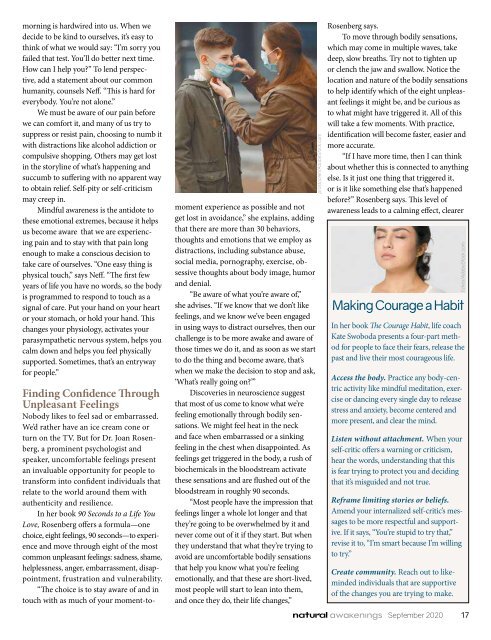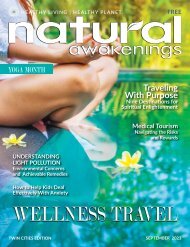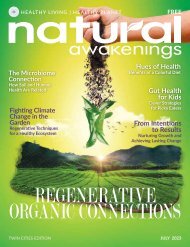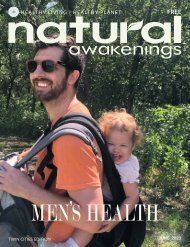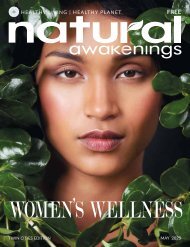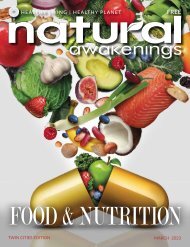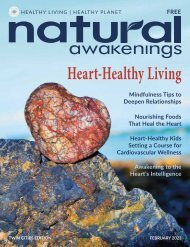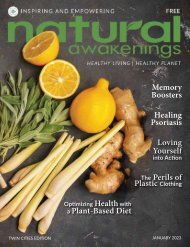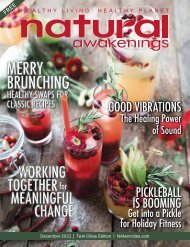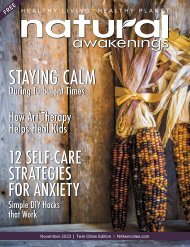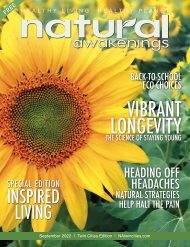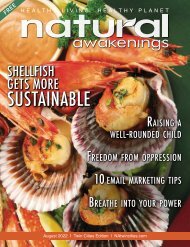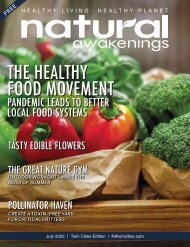Natural Awakenings Twin Cities September 2020
Read the September 2020 edition of Natural Awakenings Twin Cities. This month we focus on Emotional Wellbeing and Adaptive Yoga. Includes articles on overcoming anxiety and worry, the health benefits of mushrooms and saffron, achieving eye health and more. Natural Awakenings Twin Cities magazine is your source for healthy living, healthy planet information. Have you visited our website lately? Sign up for our Newsletter and Digital Magazine, read archived articles from local experts, and keep up with local healthy living events. Visit NATwinCities.com today.
Read the September 2020 edition of Natural Awakenings Twin Cities. This month we focus on Emotional Wellbeing and Adaptive Yoga. Includes articles on overcoming anxiety and worry, the health benefits of mushrooms and saffron, achieving eye health and more. Natural Awakenings Twin Cities magazine is your source for healthy living, healthy planet information. Have you visited our website lately? Sign up for our Newsletter and Digital Magazine, read archived articles from local experts, and keep up with local healthy living events. Visit NATwinCities.com today.
Create successful ePaper yourself
Turn your PDF publications into a flip-book with our unique Google optimized e-Paper software.
morning is hardwired into us. When we<br />
decide to be kind to ourselves, it’s easy to<br />
think of what we would say: “I’m sorry you<br />
failed that test. You’ll do better next time.<br />
How can I help you?” To lend perspective,<br />
add a statement about our common<br />
humanity, counsels Neff. “This is hard for<br />
everybody. You’re not alone.”<br />
We must be aware of our pain before<br />
we can comfort it, and many of us try to<br />
suppress or resist pain, choosing to numb it<br />
with distractions like alcohol addiction or<br />
compulsive shopping. Others may get lost<br />
in the storyline of what’s happening and<br />
succumb to suffering with no apparent way<br />
to obtain relief. Self-pity or self-criticism<br />
may creep in.<br />
Mindful awareness is the antidote to<br />
these emotional extremes, because it helps<br />
us become aware that we are experiencing<br />
pain and to stay with that pain long<br />
enough to make a conscious decision to<br />
take care of ourselves. “One easy thing is<br />
physical touch,” says Neff. “The first few<br />
years of life you have no words, so the body<br />
is programmed to respond to touch as a<br />
signal of care. Put your hand on your heart<br />
or your stomach, or hold your hand. This<br />
changes your physiology, activates your<br />
parasympathetic nervous system, helps you<br />
calm down and helps you feel physically<br />
supported. Sometimes, that’s an entryway<br />
for people.”<br />
Finding Confidence Through<br />
Unpleasant Feelings<br />
Nobody likes to feel sad or embarrassed.<br />
We’d rather have an ice cream cone or<br />
turn on the TV. But for Dr. Joan Rosenberg,<br />
a prominent psychologist and<br />
speaker, uncomfortable feelings present<br />
an invaluable opportunity for people to<br />
transform into confident individuals that<br />
relate to the world around them with<br />
authenticity and resilience.<br />
In her book 90 Seconds to a Life You<br />
Love, Rosenberg offers a formula—one<br />
choice, eight feelings, 90 seconds—to experience<br />
and move through eight of the most<br />
common unpleasant feelings: sadness, shame,<br />
helplessness, anger, embarrassment, disappointment,<br />
frustration and vulnerability.<br />
“The choice is to stay aware of and in<br />
touch with as much of your moment-tomoment<br />
experience as possible and not<br />
get lost in avoidance,” she explains, adding<br />
that there are more than 30 behaviors,<br />
thoughts and emotions that we employ as<br />
distractions, including substance abuse,<br />
social media, pornography, exercise, obsessive<br />
thoughts about body image, humor<br />
and denial.<br />
“Be aware of what you’re aware of,”<br />
she advises. “If we know that we don’t like<br />
feelings, and we know we’ve been engaged<br />
in using ways to distract ourselves, then our<br />
challenge is to be more awake and aware of<br />
those times we do it, and as soon as we start<br />
to do the thing and become aware, that’s<br />
when we make the decision to stop and ask,<br />
‘What’s really going on?’”<br />
Discoveries in neuroscience suggest<br />
that most of us come to know what we’re<br />
feeling emotionally through bodily sensations.<br />
We might feel heat in the neck<br />
and face when embarrassed or a sinking<br />
feeling in the chest when disappointed. As<br />
feelings get triggered in the body, a rush of<br />
biochemicals in the bloodstream activate<br />
these sensations and are flushed out of the<br />
bloodstream in roughly 90 seconds.<br />
“Most people have the impression that<br />
feelings linger a whole lot longer and that<br />
they’re going to be overwhelmed by it and<br />
never come out of it if they start. But when<br />
they understand that what they’re trying to<br />
avoid are uncomfortable bodily sensations<br />
that help you know what you’re feeling<br />
emotionally, and that these are short-lived,<br />
most people will start to lean into them,<br />
and once they do, their life changes,”<br />
prostooleh/AdobeStock.com<br />
Rosenberg says.<br />
To move through bodily sensations,<br />
which may come in multiple waves, take<br />
deep, slow breaths. Try not to tighten up<br />
or clench the jaw and swallow. Notice the<br />
location and nature of the bodily sensations<br />
to help identify which of the eight unpleasant<br />
feelings it might be, and be curious as<br />
to what might have triggered it. All of this<br />
will take a few moments. With practice,<br />
identification will become faster, easier and<br />
more accurate.<br />
“If I have more time, then I can think<br />
about whether this is connected to anything<br />
else. Is it just one thing that triggered it,<br />
or is it like something else that’s happened<br />
before?” Rosenberg says. This level of<br />
awareness leads to a calming effect, clearer<br />
Making Courage a Habit<br />
In her book The Courage Habit, life coach<br />
Kate Swoboda presents a four-part method<br />
for people to face their fears, release the<br />
past and live their most courageous life.<br />
Access the body. Practice any body-centric<br />
activity like mindful meditation, exercise<br />
or dancing every single day to release<br />
stress and anxiety, become centered and<br />
more present, and clear the mind.<br />
Listen without attachment. When your<br />
self-critic offers a warning or criticism,<br />
hear the words, understanding that this<br />
is fear trying to protect you and deciding<br />
that it’s misguided and not true.<br />
Reframe limiting stories or beliefs.<br />
Amend your internalized self-critic’s messages<br />
to be more respectful and supportive.<br />
If it says, “You’re stupid to try that,”<br />
revise it to, “I’m smart because I’m willing<br />
to try.”<br />
Create community. Reach out to likeminded<br />
individuals that are supportive<br />
of the changes you are trying to make.<br />
<strong>September</strong> <strong>2020</strong><br />
fizkes/AdobeStock.com<br />
17


